How Color Changes with Water Depth
- Lauren A. Moe
- Jan 5, 2023
- 4 min read
Updated: Jul 7, 2023
Water has the ability to change the way colors are seen, from your swimsuit to fish scales, to entire coral reefs. This phenomenon of color loss underwater relies on physics.
Some colors seem to “disappear” at certain depths of the ocean, meaning they stop absorbing light and appear black. The water absorbs light produced by the sun; this is called white light, which is a combination of every color (we’ll get into that later). The color of visible light depends on its wavelength, but what does that mean? For this, we’re going to visualize a demonstration together. Imagine holding each end of a Slinky in your hands, tight enough that its not drooping between them. If you stretch this Slinky, the distance between the top of one loop and the top of the one next to it increases. The Slinky is acting like a wavelength, and the distance between loops is how you measure it. When the Slinky is stretched, we’re going to say the distance between loops is 7 cm. Now, let’s squish it back together a bit, so that the loops are only 4 cm apart and the “wavelength” is shortened.
Let’s take the demonstration one step further. If the Slinky were a real wavelength, those distances between loops would be 700 nm and 400 nm. When the wavelength is stretched to 700 nm, it would be red rather than white like the wavelengths from the sun. At 400nm, the wavelength would be violet. Any wavelength between these two would exhibit a different color of the rainbow (shown in the image below). The sun emits white light because it consists of many wavelengths of different colors, all ranging from 400-700 nm.

Image Source: Randy Russel via Windows to the Universe
When you first learned about art in elementary school, you were shown a color wheel. When you mixed all the paint colors together, you got black. With light, the more colors added, the closer to white you get. Any colorful item will appear black without light, right? But have you ever experimented with colored films over light? If you shine a white flashlight onto a pair of red socks, the socks are actually absorbing all the other colors and reflecting back the red for us to see. If you were to shine a red light on the socks, it would still appear red. However, if you shine a green or blue light on the socks, there would be no red wavelengths for the socks to reflect and they would appear black. A bit confusing, but neat, right?
As the sun emits white light into the ocean, the longer wavelengths (which have more energy) are absorbed first; the energy of each wavelength is transferred into the water particles. Because red has the longest wavelength of visible color, it is also the first to disappear in water. With the lack of red wavelengths, any red items below about 20 feet will seem black. The graphic below shows the colors and when they disappear in water.

Image Source: The University of Minnesota Sea Grant Program
Fun fact: Because wavelengths contain energy, when they are absorbed, the heat from this energy is also transferred to the object. This is why white objects remain much cooler in the sun than black does- white reflects all the wavelengths, and black absorbs them!
Let’s get back to the colorful ocean graphic above. If we know that longer wavelengths such as red and orange are absorbed better, why is blue the color we see best? Shouldn’t the ocean be… purple? While the colors of visible light are the ones discussed here, wavelengths both higher and lower than the 400-700 nm range exist. Beyond 700 nm, the invisible infrared makes up over half of the sun’s emissions. We see the ocean as different shades of blue because the sun emits more of these wavelengths than violet, as well as the fact that humans can see blue better than violet. The graph below shows the amount of each color emitted by the sun, and you can see the violet is just on the cusp of visible light.

Image Source: Labster Theory





